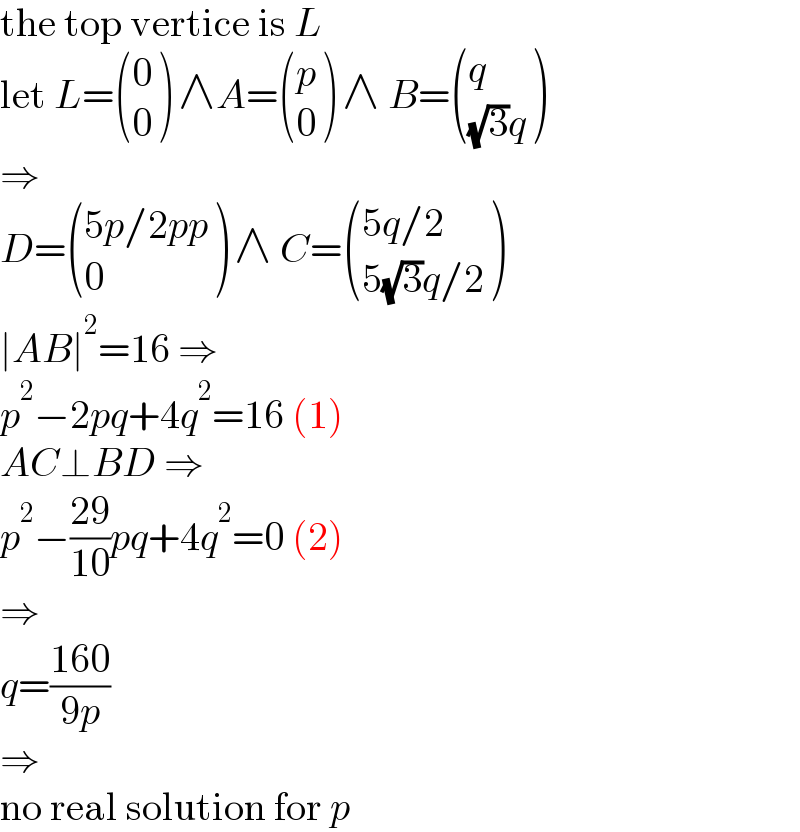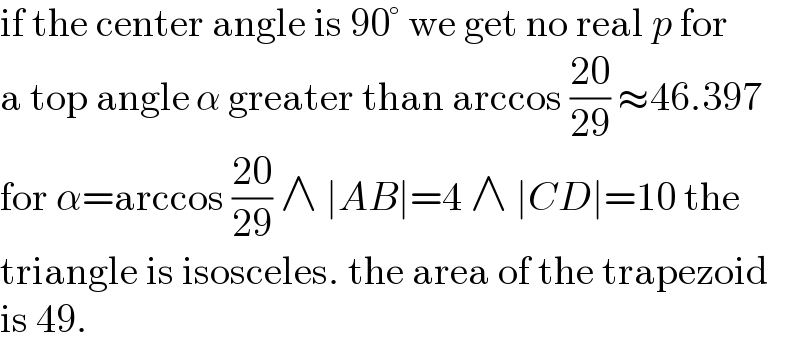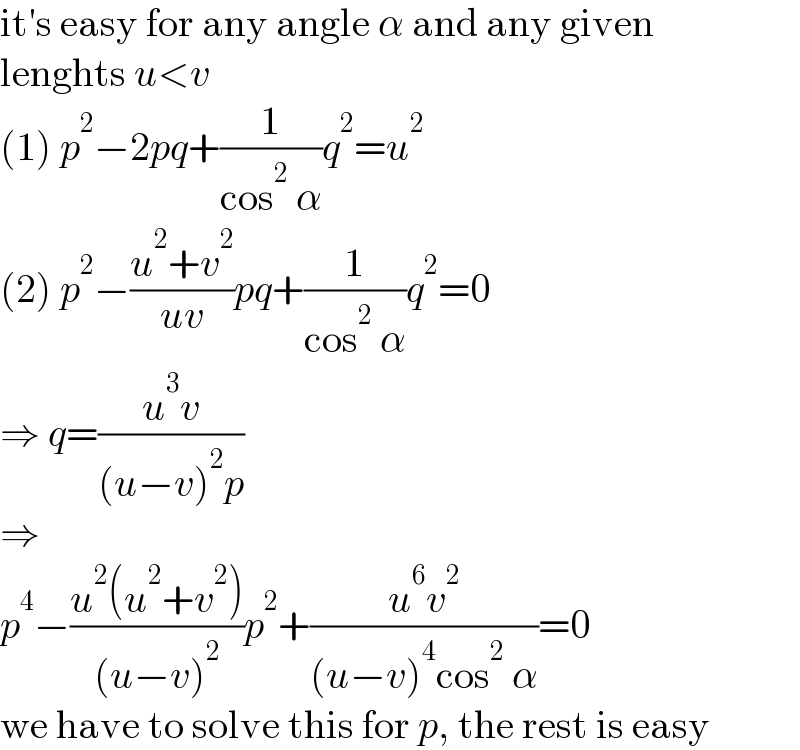
Question Number 181070 by mr W last updated on 21/Nov/22

Commented by mr W last updated on 21/Nov/22
![[Q181055 modified] find the area of trapazoid ABCD.](Q181071.png)
$$\left[{Q}\mathrm{181055}\:{modified}\right] \\ $$$${find}\:{the}\:{area}\:{of}\:{trapazoid}\:{ABCD}. \\ $$
Commented by Maxtein last updated on 21/Nov/22

$$\mathrm{60}{degree}\:\mathrm{4}\:\mathrm{60}{degree}\:\mathrm{10} \\ $$
Answered by MJS_new last updated on 21/Nov/22

$$\mathrm{the}\:\mathrm{top}\:\mathrm{vertice}\:\mathrm{is}\:{L} \\ $$$$\mathrm{let}\:{L}=\begin{pmatrix}{\mathrm{0}}\\{\mathrm{0}}\end{pmatrix}\:\wedge{A}=\begin{pmatrix}{{p}}\\{\mathrm{0}}\end{pmatrix}\:\wedge\:{B}=\begin{pmatrix}{{q}}\\{\sqrt{\mathrm{3}}{q}}\end{pmatrix} \\ $$$$\Rightarrow \\ $$$${D}=\begin{pmatrix}{\mathrm{5}{p}/\mathrm{2}{pp}}\\{\mathrm{0}}\end{pmatrix}\:\wedge\:{C}=\begin{pmatrix}{\mathrm{5}{q}/\mathrm{2}}\\{\mathrm{5}\sqrt{\mathrm{3}}{q}/\mathrm{2}}\end{pmatrix} \\ $$$$\mid{AB}\mid^{\mathrm{2}} =\mathrm{16}\:\Rightarrow \\ $$$${p}^{\mathrm{2}} −\mathrm{2}{pq}+\mathrm{4}{q}^{\mathrm{2}} =\mathrm{16}\:\left(\mathrm{1}\right) \\ $$$${AC}\bot{BD}\:\Rightarrow \\ $$$${p}^{\mathrm{2}} −\frac{\mathrm{29}}{\mathrm{10}}{pq}+\mathrm{4}{q}^{\mathrm{2}} =\mathrm{0}\:\left(\mathrm{2}\right) \\ $$$$\Rightarrow \\ $$$${q}=\frac{\mathrm{160}}{\mathrm{9}{p}} \\ $$$$\Rightarrow \\ $$$$\mathrm{no}\:\mathrm{real}\:\mathrm{solution}\:\mathrm{for}\:{p} \\ $$
Commented by MJS_new last updated on 21/Nov/22

$$\mathrm{if}\:\mathrm{the}\:\mathrm{center}\:\mathrm{angle}\:\mathrm{is}\:\mathrm{90}°\:\mathrm{we}\:\mathrm{get}\:\mathrm{no}\:\mathrm{real}\:{p}\:\mathrm{for} \\ $$$$\mathrm{a}\:\mathrm{top}\:\mathrm{angle}\:\alpha\:\mathrm{greater}\:\mathrm{than}\:\mathrm{arccos}\:\frac{\mathrm{20}}{\mathrm{29}}\:\approx\mathrm{46}.\mathrm{397} \\ $$$$\mathrm{for}\:\alpha=\mathrm{arccos}\:\frac{\mathrm{20}}{\mathrm{29}}\:\wedge\:\mid{AB}\mid=\mathrm{4}\:\wedge\:\mid{CD}\mid=\mathrm{10}\:\mathrm{the} \\ $$$$\mathrm{triangle}\:\mathrm{is}\:\mathrm{isosceles}.\:\mathrm{the}\:\mathrm{area}\:\mathrm{of}\:\mathrm{the}\:\mathrm{trapezoid} \\ $$$$\mathrm{is}\:\mathrm{49}. \\ $$
Commented by mr W last updated on 21/Nov/22

$${yes},\:{you}\:{are}\:{right}\:{sir}.\:{i}\:{had}\:{a}\:{mistake} \\ $$$${in}\:{my}\:{consideration}. \\ $$$${please}\:{solve}\:{for}\:\theta=\mathrm{30}°\:{instead}\:{of}\:\mathrm{60}°. \\ $$
Commented by MJS_new last updated on 21/Nov/22

$$\mathrm{it}'\mathrm{s}\:\mathrm{easy}\:\mathrm{for}\:\mathrm{any}\:\mathrm{angle}\:\alpha\:\mathrm{and}\:\mathrm{any}\:\mathrm{given} \\ $$$$\mathrm{lenghts}\:{u}<{v} \\ $$$$\left(\mathrm{1}\right)\:{p}^{\mathrm{2}} −\mathrm{2}{pq}+\frac{\mathrm{1}}{\mathrm{cos}^{\mathrm{2}} \:\alpha}{q}^{\mathrm{2}} ={u}^{\mathrm{2}} \\ $$$$\left(\mathrm{2}\right)\:{p}^{\mathrm{2}} −\frac{{u}^{\mathrm{2}} +{v}^{\mathrm{2}} }{{uv}}{pq}+\frac{\mathrm{1}}{\mathrm{cos}^{\mathrm{2}} \:\alpha}{q}^{\mathrm{2}} =\mathrm{0} \\ $$$$\Rightarrow\:{q}=\frac{{u}^{\mathrm{3}} {v}}{\left({u}−{v}\right)^{\mathrm{2}} {p}} \\ $$$$\Rightarrow \\ $$$${p}^{\mathrm{4}} −\frac{{u}^{\mathrm{2}} \left({u}^{\mathrm{2}} +{v}^{\mathrm{2}} \right)}{\left({u}−{v}\right)^{\mathrm{2}} }{p}^{\mathrm{2}} +\frac{{u}^{\mathrm{6}} {v}^{\mathrm{2}} }{\left({u}−{v}\right)^{\mathrm{4}} \mathrm{cos}^{\mathrm{2}} \:\alpha}=\mathrm{0} \\ $$$$\mathrm{we}\:\mathrm{have}\:\mathrm{to}\:\mathrm{solve}\:\mathrm{this}\:\mathrm{for}\:{p},\:\mathrm{the}\:\mathrm{rest}\:\mathrm{is}\:\mathrm{easy} \\ $$
Commented by MJS_new last updated on 21/Nov/22

$$\mathrm{for}\:\alpha=\mathrm{30}°\wedge{u}=\mathrm{4}\wedge{v}=\mathrm{10}\:\mathrm{I}\:\mathrm{get}\:\frac{\mathrm{140}\sqrt{\mathrm{3}}}{\mathrm{9}}\:\mathrm{for}\:\mathrm{the} \\ $$$$\mathrm{area}\:\mathrm{of}\:\mathrm{the}\:\mathrm{trapezoid} \\ $$
Commented by mr W last updated on 21/Nov/22

$${thanks}\:{alot}\:{sir}!\:{i}\:{got}\:{the}\:{same}. \\ $$
Answered by mr W last updated on 21/Nov/22

Commented by mr W last updated on 21/Nov/22
![x^2 +y^2 =4^2 6^2 =x^2 +(2.5y)^2 +y^2 +(2.5x)^2 −(√(3(x^2 +(2.5y)^2 )(y^2 +(2.5x)^2 ))) 80=(√(3(x^2 +(2.5y)^2 )(y^2 +(2.5x)^2 ))) ((6400)/3)=(16+5.25y^2 )(16+5.25x^2 ) ((6400)/3)=6.25×16^2 +5.25^2 x^2 y^2 ⇒xy=((40)/( (√3)×5.25))=((160(√3))/(63)) A_([ABCD]) =((3.5x×3.5y)/2)=((12.25xy)/2) =((12.25)/2)×((160(√3))/(63))=((140(√3))/( 9))](Q181106.png)
$${x}^{\mathrm{2}} +{y}^{\mathrm{2}} =\mathrm{4}^{\mathrm{2}} \\ $$$$\mathrm{6}^{\mathrm{2}} ={x}^{\mathrm{2}} +\left(\mathrm{2}.\mathrm{5}{y}\right)^{\mathrm{2}} +{y}^{\mathrm{2}} +\left(\mathrm{2}.\mathrm{5}{x}\right)^{\mathrm{2}} −\sqrt{\mathrm{3}\left({x}^{\mathrm{2}} +\left(\mathrm{2}.\mathrm{5}{y}\right)^{\mathrm{2}} \right)\left({y}^{\mathrm{2}} +\left(\mathrm{2}.\mathrm{5}{x}\right)^{\mathrm{2}} \right)} \\ $$$$\mathrm{80}=\sqrt{\mathrm{3}\left({x}^{\mathrm{2}} +\left(\mathrm{2}.\mathrm{5}{y}\right)^{\mathrm{2}} \right)\left({y}^{\mathrm{2}} +\left(\mathrm{2}.\mathrm{5}{x}\right)^{\mathrm{2}} \right)} \\ $$$$\frac{\mathrm{6400}}{\mathrm{3}}=\left(\mathrm{16}+\mathrm{5}.\mathrm{25}{y}^{\mathrm{2}} \right)\left(\mathrm{16}+\mathrm{5}.\mathrm{25}{x}^{\mathrm{2}} \right) \\ $$$$\frac{\mathrm{6400}}{\mathrm{3}}=\mathrm{6}.\mathrm{25}×\mathrm{16}^{\mathrm{2}} +\mathrm{5}.\mathrm{25}^{\mathrm{2}} {x}^{\mathrm{2}} {y}^{\mathrm{2}} \\ $$$$\Rightarrow{xy}=\frac{\mathrm{40}}{\:\sqrt{\mathrm{3}}×\mathrm{5}.\mathrm{25}}=\frac{\mathrm{160}\sqrt{\mathrm{3}}}{\mathrm{63}} \\ $$$${A}_{\left[{ABCD}\right]} =\frac{\mathrm{3}.\mathrm{5}{x}×\mathrm{3}.\mathrm{5}{y}}{\mathrm{2}}=\frac{\mathrm{12}.\mathrm{25}{xy}}{\mathrm{2}} \\ $$$$\:\:\:\:\:\:\:\:\:\:\:\:\:\:\:\:=\frac{\mathrm{12}.\mathrm{25}}{\mathrm{2}}×\frac{\mathrm{160}\sqrt{\mathrm{3}}}{\mathrm{63}}=\frac{\mathrm{140}\sqrt{\mathrm{3}}}{\:\mathrm{9}} \\ $$
